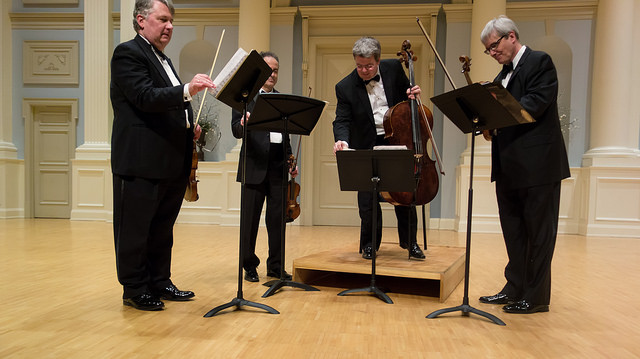By Colleen Mertes
Contributor
The Emerson String Quartet not only connected music to the human experiences of laughter, romance and tension, but exposed the beauty of a live performance. The recital hall of the Staller Center for the Arts had a full house buzzing with chatter that grew uneasy as the clock ticked past 8 p.m. Then, around 8:07 p.m., the lights dimmed, hushing the crowd until the light hum of tuning could be heard from backstage. The quartet entered: Eugene Drucker: violin, Philip Setzer: violin, Lawrence Dutton: viola, and Paul Watkins: cello.
They began to play Haydn’s String Quartet in E-flat Major, Op. 33, No. 2, more commonly referred to as “The Joke”. It was an enjoyably light and comfortable piece to listen to as the night began. Haydn’s work showcased the cohesiveness of the quartet; at times the Largo required all four musicians to play in sync, which is more easily said than done. The Presto displayed the dexterous and delicate hand of the violins.
The “joke” was revealed at the end of the piece, as short bursts of playing followed by increasing pauses makes a question of the finale. When the piece was finished, the crowd was elated; over the enthusiastic clapping, the praise “beautiful” was heard. After the second round of bows, the crowd was buzzing in anticipation, though they couldn’t have prepared for the act that followed.
Berg’s Lyric Suite, as told in the notes by Helen Sive Paxton found in the program, is an “intensely emotional and expressive work,” which is now known to be a description of Berg’s love affair with Hannah Fuchs-Robettin. But during the second movement, Andante amoroso, the second violinist, Philip Setzer, stopped abruptly. The audience was taken aback. Setzer thought he heard someone fall, which he said made him lose his place in the music. What he had actually heard was two late audience members shuffling in.
During the fifth movement, Presto delirando- Tenebroso, as Lawrence Dutton vigorously played, his viola’s strings popped out of place. As the audience waited for Dutton to return from repairing his instrument, the trio of taught-stringed performers were left exposed on the stage.
Setzer stepped up and seized the opportunity to entertain and educate; he broke through the tension with intriguing knowledge. George Gershwin, American composer and pianist, was, as Setzer informs, “obsessed” with this piece. He said he hired a quartet to play it at every dinner party at his apartment in Paris. Before he could tell the audience any more, Dutton returned and apologized.
“Anything with B’s always breaks my strings,” Dutton said.
The last piece was a dramatic finale to an unusually eventful concert. Revel’s String Quartet in F Major ended the night with the quartet in a united crescendo. The crowd clapped for so long that the quartet came out for three separate bows. It was a success that was enhanced by its bumps because it created opportunities that could not have happened otherwise. There can be no replica of the Emerson String Quartet’s performance.


